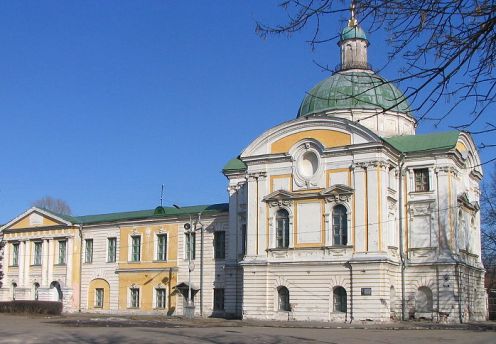

Location: Ulitsa Sovetskaya (former Millionaya) 6
Travel Palace was constructed in historic center of Tver in 1764- 66 under design of architect M.F. Kazakov. It unites architectural elements of Classicism and Baroque. This royal residence was built for Russian Empress Catherine the Great who wanted a more appropriate resting place during her travel from Russian capital of Saint Petersburg to medieval capital of Moscow. In the early 19th century the palace was reconstructed under new design of Karl Rossi. Travel Palace in Tver at the time was owned by granddaughter of Empress Catherine, Catherine Pavlovna, sister of Emperor Alexander I. She married the governor of Tver and wanted to turn old palace into new center piece of social life in the city.
Tver Travel Palace During the war and today
History
The palace with two pavilions was built
in 1764-1766 in the classicism style with baroque elements according
to the project of P.R. Nikitin. The widespread opinion about the
authorship of M.F. Kazakov has no historical basis.
The
palace was intended for the rest of the members of the imperial
family on the way from St. Petersburg to Moscow, from where it got
its name. On February 12, 1767, Empress Catherine II first arrived
at the Tver Travel Palace.
The palace was rebuilt by K. I.
Rossi at the beginning of the 19th century. At this time, the sister
of Alexander I, Ekaterina Pavlovna, who was married to the governor
of Tver, Georg Oldenburgsky, lived here. She turned the palace into
one of the centers of the country's social life and a fashionable
literary salon, where the high society of Tver gathered and where
many outstanding people from Moscow and St. Petersburg came. NM
Karamzin read here to Emperor Alexander excerpts from his "History".
In 1864, the palace was imperceptibly and subtly supplemented by
A. I. Rezanov, who undertook another restructuring, this time in the
"old style", so it is very difficult to distinguish from the side of
its addition from the historical building of Nikitin. F. M. Avetisov
took part in the restructuring.
Councils of workers 'and
peasants' deputies, as well as the provincial executive committee
worked in the building of the traveling palace. On October 28
(November 10), revolutionary A.P. Vagzhanov announced the victory of
Soviet power. In the fall of 1941, the building was partially
destroyed by the Nazis, in 1942-1948. restored.
At the
present time the regional art gallery is located in the Travel
Palace. Since the late 1990s, the Travel Palace has been under
reconstruction. Since August 2012 it has been finally closed for
restoration. In July 2015, restoration work was completed, and work
was underway to restore the imperial garden. In 2017, the palace was
opened in test mode - for organized excursion groups, from November
30, 2017 it was open for individual visitors and tourist groups.
The complex of buildings of the Tver Imperial Palace is an
example of ceremonial architecture of the 18th-19th centuries,
consisting of the main building, an outhouse, a carriage shed, a
stable, a guardhouse, the Palace Garden, a greenhouse and the
building of a former real school.